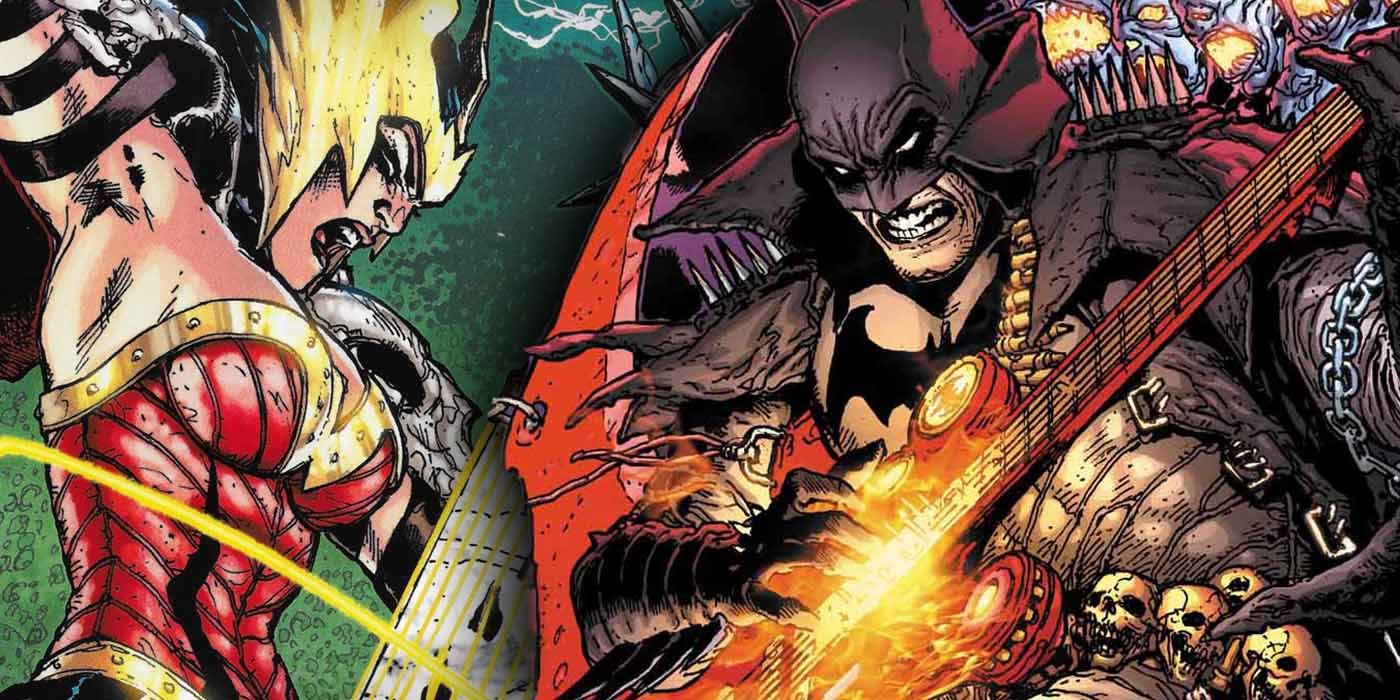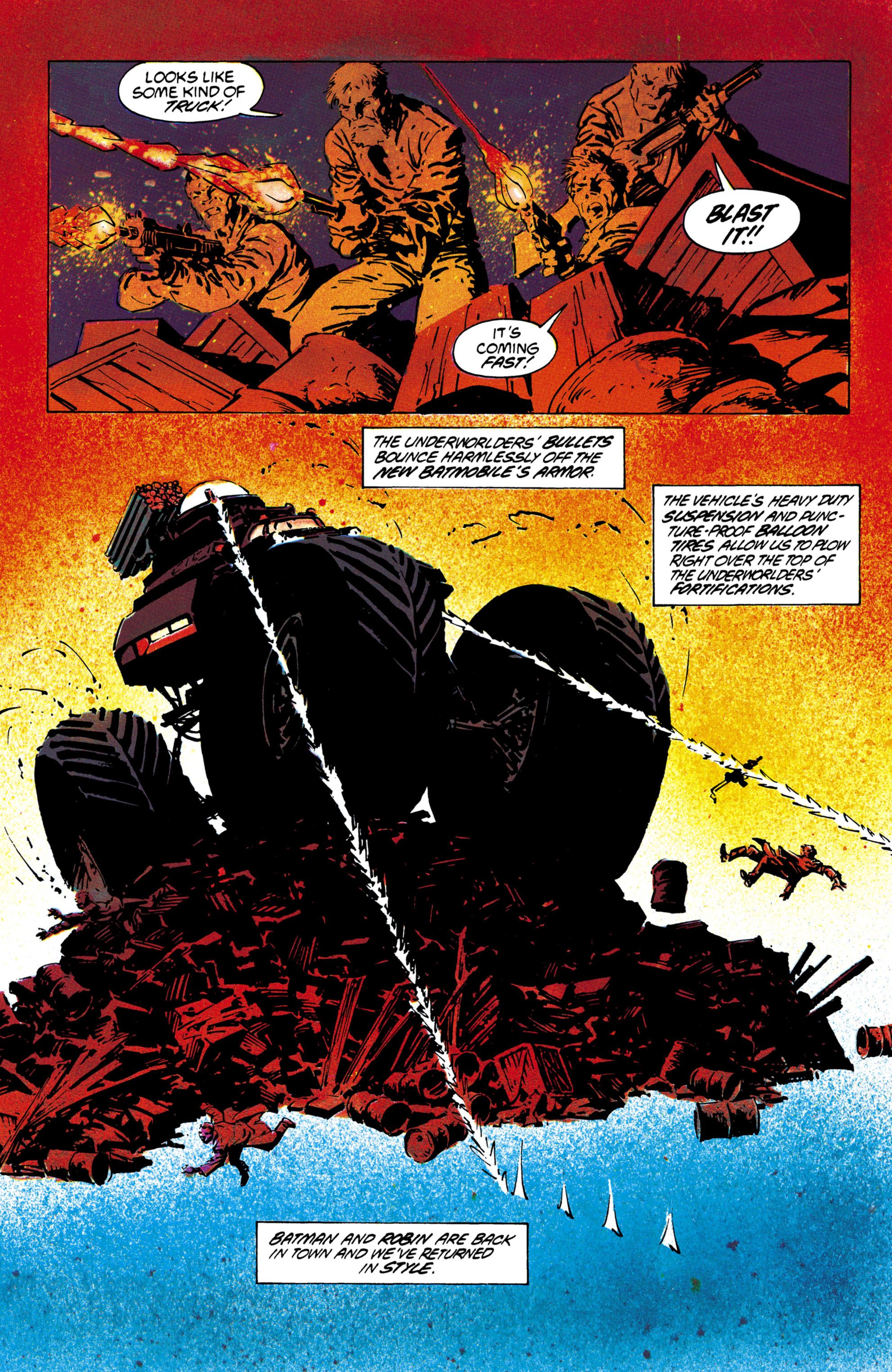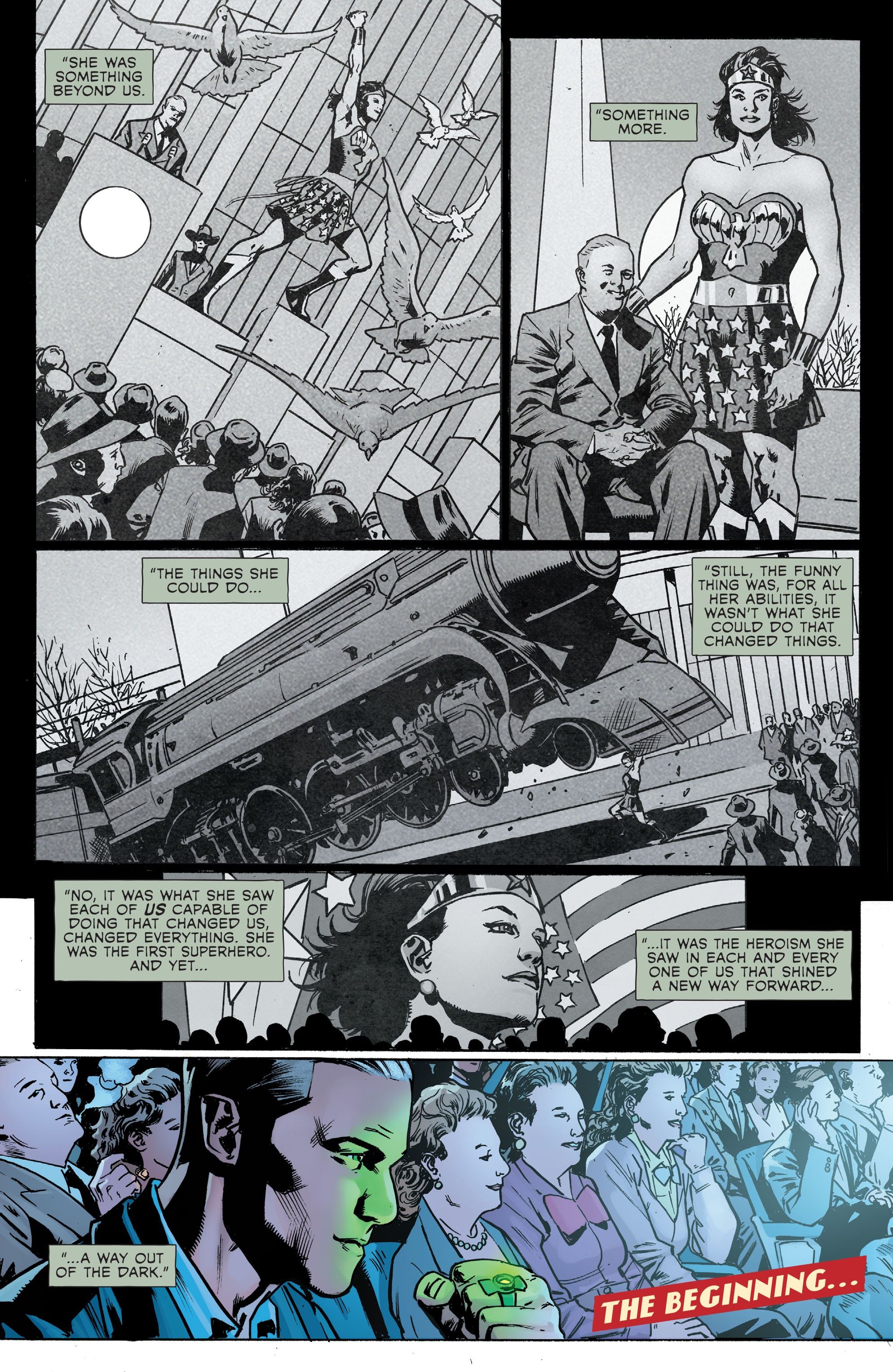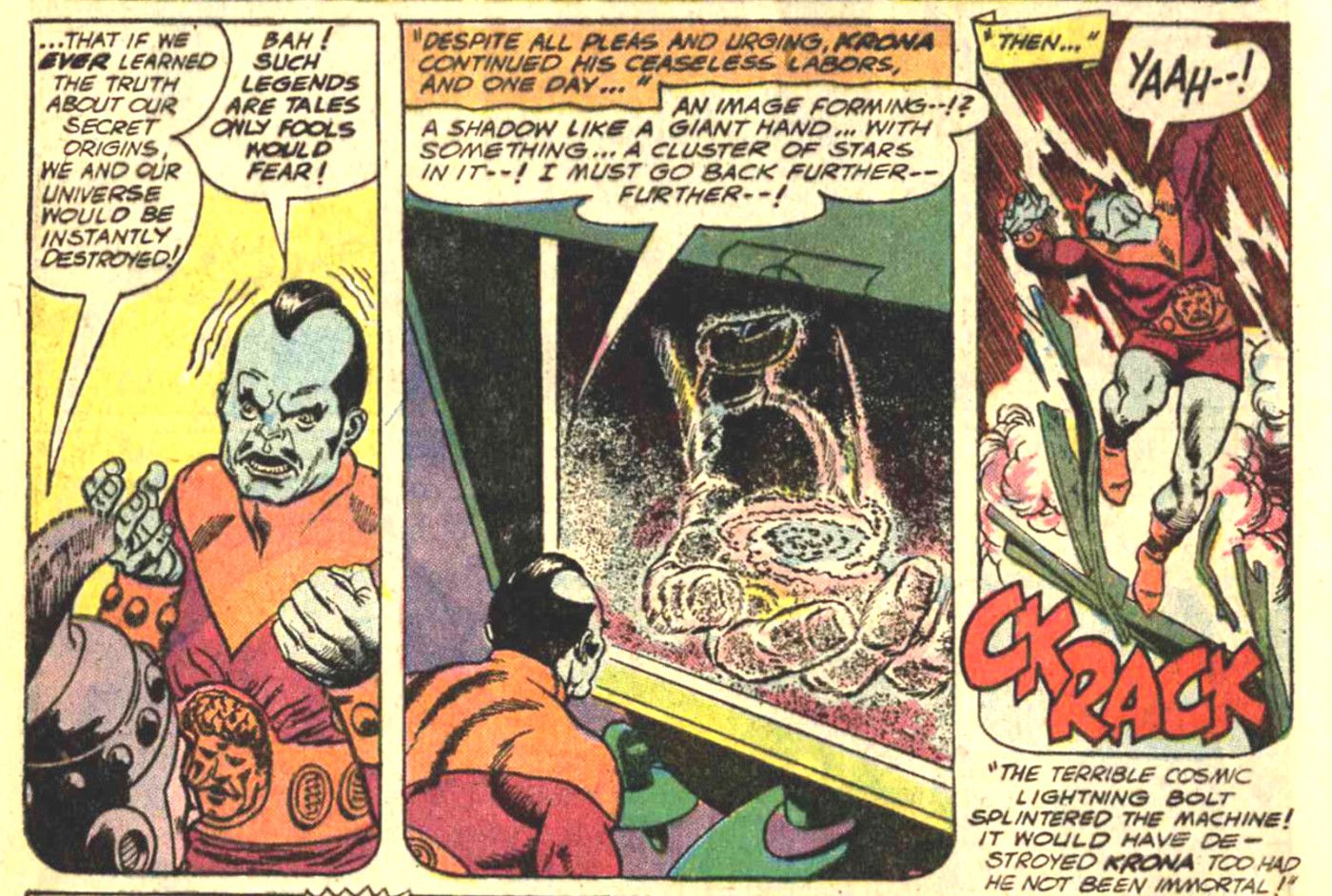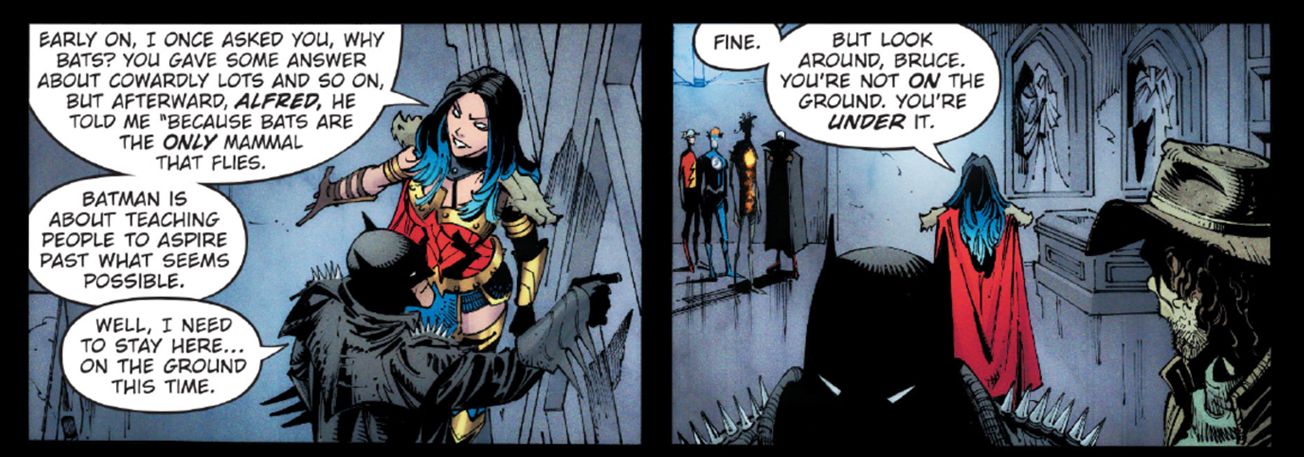WARNING: The following contains spoilers for Dark Nights: Death Metal #2 by Scott Snyder, Greg Capullo, Jonathan Glapion, FCO Plascencia and Tom Napolitano, available now.
The house lights are down, the volume is up, and Dark Nights: Death Metal is shredding through the DC Universe. Death Metal#1 threw a lot of crazy concepts and characters at us readers, so Death Metal #2 dials the pace down just a little. It's like a slower song at a rock concert that's still good on its own but lets the crowd catch its breath before the big things to come. And in this case, we do mean "big things." So get your lighters out and your copy of Death Metal #2 ready, because have we got some liner notes for you!
Dark Nights: Death Metal #2 was written by Scott Snyder, penciled by Greg Capullo, inked by Jonathan Glapion, colored by FCO Plascencia, and lettered by Tom Napolitano. Jared Blando is credited as "cartographer," while Darran Robinson designed the publication. The associate editor was Andrew Marino, and the issue was edited by Marie Javins.
We're not going to spend a lot of time on the credits' nicknames this issue because they don't seem to be going for specific song references. Instead, they are more generally hardcore. We do note that "Chosen Ones" is a Megadeth song, "God-Killer" was the name of Wonder Woman's sword (or so it seemed) in the Wonder Woman movie; "Fists of Fury" is a Kamasi Washington song; "Deathless" was a song from Miss May I; and "Savior" is the title of songs from Rise Against, Skillet and Iggy Azalea.
The Many Deaths Of The Batmen (Pages 1-2, 13, 16, 21)
The issue kicks off with a lizard, similar to how Metal #1 opened "50,000 years ago" with a lizard apparently being killed horribly by a bat. Ironically, though, the lizard in Death Metal #2 is a "bat." As he sheds his skin we see he's the "Batom," a Bruce Wayne (one presumes) crossed with the Atom's size-changing technology. Needless to say, it's a riff on the Silver Age Atom, Ray Palmer, who was created by Julius Schwartz, Gardner Fox and Gil Kane for October 1961's Showcase DEth Metal #34.
While the comics Atom has gone mostly for spandex, the Batom wears an armored suit like the one on the various Arrowverse TV series, most notably DC's Legends of Tomorrow. This makes us wonder whether the Batom version has the same kind of energy weapons that the LOT suit does. Of course, we'll never know – just as we'll never know what sort of darkly (and, one hopes, hilariously) traumatic Dark Multiverse world birthed this particular combination; because the Batom gets run over by our next Dark Multiversal mash-up.
The Batmobeast (Pages 1-2) is not the comics' first Bat-themed monster truck. That honor goes to the Dynamic Duo's distinctive lifted ride from Jim Starlin and Berni Wrightson's 1988 Batman: The Cult miniseries. (Coincidentally, The Cult is also the name of a classic metal band.) That vehicle reappeared during the extended "No Man's Land" storyline, where it helped Batman get around quake-ravaged Gotham. In the real world, there is a competitive monster truck called "Batman" which kind of looks like Batmobeast, but probably doesn't share a lot of other features with it.
Anyway, the lesson from this issue seems to be to not get too attached to these Dark Multiversal Batmen. In rapid succession, we say goodbye to B. Rex (Page 13), Batmage and Beyond (Page 16) and the Dr. Arkham who somehow is also Bruce Wayne (Page 21). At this point, we don't know whether to be sad or relieved that we probably won't see Ambush-Bat or Suga-Robin & Spiked-Bat-Cowl.
Regardless, Page 16 gives us the Robin King, the kid who will surpass the Batman Who Laughs because he literally doesn't know any better. Page 17 suggests that his "crow" refrain morphs into "crown," which would seem to require a little verbal gymnastics to handle the changing vowel sounds.
On Page 18, the Batman Who Laughs dubs himself The Darkest Knight. No offense, but we think that may be a hard sell and we'll probably still call him the Batman Who Laughs just out of habit. In any event, he is not to be confused with the Grim Knight, a gun-wielding Batman from an unidentified Dark Multiverse Earth who appeared in the Batman Who Laughs miniseries.
Finally, we didn't do a rundown on Evil Batman Beyond, seen in Death Metal#1 and in this issue starting on Page 12, because we weren't sure about the mash-up, until Snyder clarified matters on Twitter. Batman Beyond was an animated TV series created by Paul Dini, Bruce Timm and Alan Burnett which ran for 52 episodes from January 10, 1999 to December 18, 2001. The Batman of 2039 is Terry McGinnis, a high school student who becomes the retired Bruce Wayne's protegé. Because it's the future, Terry gets a high-tech Batsuit which lets him fly and has stealth capabilities.This "Beyond" suit showed up in comics in October 2005's Superman/Batman #22, although that issue implied that then-current Robin Tim Drake was wearing it. Terry himself appeared in January 2008's Countdown to Final Crisis #22, where he lived on Earth-12. Terry and Tim both figured into 2014-15's year-long Futures End miniseries, and Batman Beyond has been an ongoing comic pretty much since then. The regular Beyond suit is black with red highlights, so this suit reverses that color scheme.
Respect Your Elders (Pages 4-5)
Sheldon Mayer created Abigail Mathilda "Ma" Hunkel (mentioned as a password on Pages 4-5) for June 1939's All-American Comics #3. Her adventures as the original Red Tornado started in November 1940's issue #20. She popped in briefly to the JSA's first meeting, but her relationship to the team wasn't revealed until decades later, in flashback stories from series like All-Star Squadron and JSA.
Introduced on Page 5, Green Lantern Alan Scott, Jay Garrick's Flash, Ted "Wildcat" Grant and Doctor Fate are core members of the Justice Society of America, comics' first all-star superhero team. The Justice Society debuted in Winter 1940's All-Star Comics #3, and its original run encompasses much of the Golden Age of superhero comics, before ending with All-Star #57, cover-dated February-March 1951. Green Lantern, Flash and Doctor Fate are charter members, while Wildcat guest-starred in Spring 1945's All-Star Comics #24 and had joined by Winter 1945's issue #27.
Martin Nodell, Bill Finger and editor Sheldon Mayer created the Green Lantern for July 1940's All-American Comics #16. Finger and Irwin Hasen created Wildcat for January 1942's Sensation Comics #1, which also featured the second part of Wonder Woman's debut. Gardner Fox and Harry Lampert created the Flash for January 1940's Flash Comics #1; and Fox and Howard Sherman created Doctor Fate for May 1940's More Fun Comics #55.
We're guessing from the context that this is the original Kent Nelson Fate, or at least close enough for our purposes. However, there have been a surprising number of Doctors Fate, including multiple versions existing concurrently. As of the current Justice League Dark storyline, Nelson is Fate, but he's been joined by another Nabu disciple, Khalid Nassour. Paul Levitz and Sonny Liew created Khalid, who first appeared in a short preview in July 2015's Convergence: Aquaman #2. He became Doctor Fate in August 2015's Doctor Fate #1 and was seen as Fate most recently in September 2020's Superman #23.
According to Late March 2020's Wonder Woman #750, she is definitely "old friend[s]" (Page 5) with the Justice Society. A story written by Scott Snyder and drawn by Bryan Hitch has Alan Scott in 1939 watching a newsreel of Wonder Woman in action. As of 1939, neither of these characters had yet appeared in comics, so this is a slight change to the usual "the Golden Age happened in real time" rule. Regardless, February 2020's Doomsday Clock #12 had established that Wonder Woman "fought alongside the Justice Society of America during World War II."
Page 5's exchange between Jay and Wally West mirrors Barry and Wally's reunion from the DC Universe Rebirth special. Of course, after Barry's death (and after Jay had been trapped in a time-loop with most of the other JSAers), Jay became one of Wally's mentors, as the latter grew into his role as the third Flash. Both Wally and Jay were cut out of the New 52 period, so when Jay reappeared in Early July 2017's Flash #22, Barry didn't remember him either. Apparently this was part of Doctor Manhattan's temporal tinkering, so everything went back to normal (mostly) in Doomsday Clock #12. However, thanks to the mysteries of comic-book production, the Justice Society had already reappeared in the current Rebirth timeline (during another time-and-dimension-hopping mission) in Late October 2019's Justice League #30.
Time Travel Tidbits (Pages 9-10, 15)
When Wonder Woman describes her plan to travel to the various cosmic Crises and collect their energy, our notes on Page 9 start by saying "this is a very Avengers: Endgame plot." In fact, we might just as well say that Endgame was a very Gardner Fox-ian plot. Starting with the Justice Society and continuing with the Justice League, Fox had his heroes split into small teams for preliminary missions before reuniting in the last act. As for the time-travel element, the JLA and JSA traveled to various points in the past to collect the lost members of the Seven Soldiers of Victory in August-October 1972's Justice League of America #100-102. Ten years later, the JLA/JSA team-up (in Justice League of America #207-209 and All-Star Squadron #14-15) involved trips to 1942 and 1962 to stop a nuclear war that had left the present day of 1982 post-apocalyptic.
On Page 10 the Flash mentions that there's "no way out of the present." The Justice League has encountered such literal time barriers before, including May 1962's Justice League of America #11 (while returning from a far-future encounter with the Lord of Time), February 1965's issue #33 (where the barrier was a kind of sticky goo) and November 1978's issue #160, while on the way to the Lord of Time's 35th Century headquarters.
The "hands" Perpetua mentions on Page 15 could refer to the hand which spins creation into existence, as shown in October 1965's Green Lantern #40 and in October 1985's Crisis On Infinite Earths #7. Ten billion years ago, the Oan scientist Krona wanted to do some forbidden research on the origins of the universe, so he built a time-viewer and saw a giant celestial hand sowing stars like apple seeds. Krona's Oan colleagues exiled him because -- in addition to being a disobedient jerk -- he had also unleashed evil into the universe. The Oans then dedicated themselves to fighting said evil, eventually creating an army of intergalactic peacekeepers called the Green Lantern Corps.
In January 1986's Crisis On Infinite Earths #10, the Anti-Monitor (who, you'll remember, is Perpetua's child) went back to the dawn of time to somehow "become" the hand in Krona's viewer; but the Spectre stopped him and the infinite Multiverse became a singular universe. While December 2017's Justice League of America #17 seemed to tease that this hand may have belonged to Doctor Manhattan, it's still not entirely clear whose hand it is, but clearly they are powerful enough to scare Perpetua.
Batman v. Wonder Woman: Dawn Of Philosophical Disagreement (Page 9)
On Page 9, Wonder Woman contends that "Batman is about teaching people to aspire past what seems possible." We're not arguing with this, but the underlying thrust of the Dark Multiverse -- typified by its fixation on Batman -- seems a lot like using what's possible to then past what's moral. The whole "Batman has a plan" trope might not have originated with The Dark Knight Returns -- where the aged, non-powered Batman defeated a still-pretty-formidable Superman -- but it laid the foundation for a number of "plans gone wild" stories. In the June 1990 Superman titles, "Dark Knight Over Metropolis" ended with Batman getting a chunk of Kryptonite, and the dark future of 1991's Superman Annual #3 showed the Dynamic Duo using it on a despotic Man of Steel. JLA's "Tower Of Babel" (2000) centered around Batman's plans for defeating each of his teammates. The Bat-books' "War Games" (2004) had Stephanie Brown put one of Batman's gang-destroying plans into action, with disastrous results. In 2005, The OMAC Project revealed that Batman had constructed a self-aware satellite which naturally went rogue and started killing super-people.
Of course, Batman's plans usually work well, of course; but lately – and particularly with the Dark Multiverse featured so prominently – we're being reminded that Batman's moral code is one of the few things that keeps his intellect in check. Maybe that's what's going on here; Batman is afraid to go big, both because the League already tried that and failed; and because he's afraid that if he goes too far, he'll end up like his Dark Multiversal counterparts. (He's tasted that before in the Batman Who Laughs miniseries.)
By contrast, Wonder Woman's pragmatism comes from a different perspective. With superpowers, she can do more physically than Batman can; and her training takes that into account. Because her mission of peace is also different from Batman's self-imposed crusade, it occasionally leads her down different paths; most notably when she killed Max Lord in the runup to Infinite Crisis. We are tempted to say that Wonder Woman sees a bigger picture than Batman does, although it could just be that she's better at judging the effects of the big-picture plans than he is. The famous Gail Simone quote comes to mind: "If you need to stop an asteroid, you call Superman. If you need to solve a mystery, you call Batman. But if you need to end a war, you call Wonder Woman." These are just observations, not value judgments, so we note merely that what Wonder Woman sees as "possible" in this context is necessarily different from Batman's view.
Come back for Part 2, including the crypt of heroes, Doctor Manhattan's son and an overgrown family tree!
0 Links
0 Links

